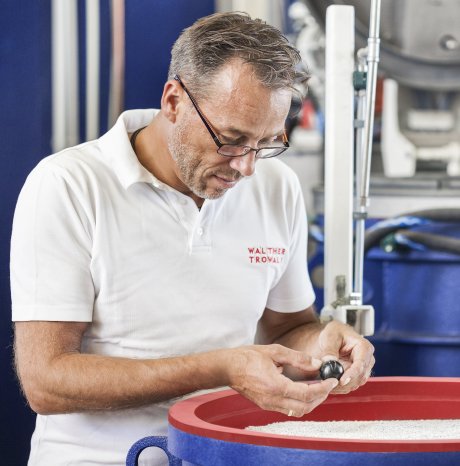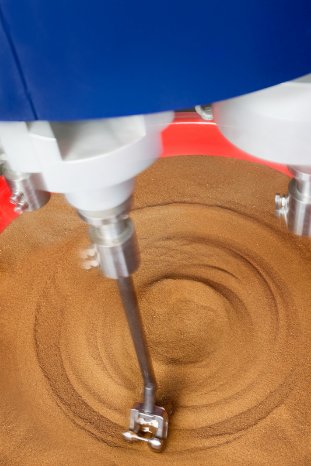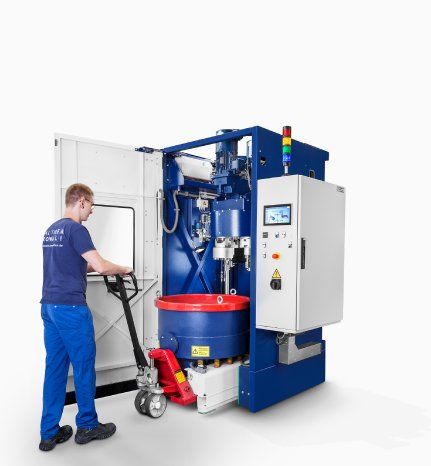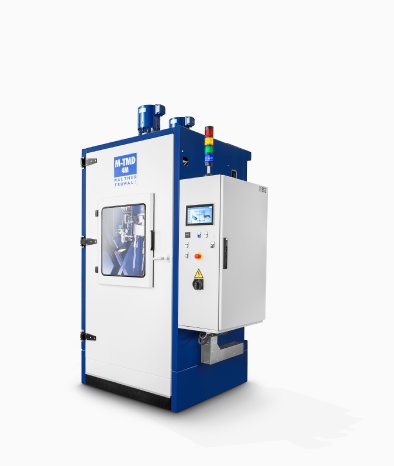- Efficient surface finishing of high-value work pieces
- Overlapping rotational work piece movement is the basis for even, all-around surface finishes
Walther Trowal developed these new machines specifically for treating high-value components requiring extremely careful handling for the complete finishing process. For example, they are utilized for finishing the surface of turbine blades, impellers for turbo chargers, precision components for pumps and compressors as well as for orthopedic implants.
The new drag machines of the M-series have a carousel with multiple rotating workstations. In turn each workstation is equipped with spindle heads containing several spindle drives onto which the work pieces are attached with special fixtures. In addition, these machines also contain a stationary work bowl filled with grinding or polishing media. As the work pieces are “dragged” through the stationary media mass, the simultaneous rotational work piece movement by carousel, workstations and spindles creates different overlapping patterns, which ensure an even and intensive coverage of the complete work piece surface.
Christoph Cruse, director of sales at Walther Trowal, foresees a big demand for these machines at some of his customers who produce delicate, high-value components. He explains: “With our new machines we want to assist the manufacturers of work pieces that must receive the best possible surface finish, and where even the slightest surface flaw or scratch might cause them to be scrapped. Furthermore, we target parts where deviations from the dimensional specifications of a few thousands mm can be a detrimental. The M-TMD drag finishers with their perfect surface coverage open brand-new possibilities for finishing such work pieces.”
Die M-TMD 4 drag finisher is equipped with four work stations and can process 12 parts in one single batch; the M-TMD 6 – with six work stations allows batch sizes of up to 18 pieces.
At this year’s IMTS Walther Trowal also displays a range of mass finishing equipment including rotary vibrators, the MV multi vib vibrators and a high-energy centrifugal disk finishing machine.
One drag finishing success story: Polishing of the extremely wear resistant ceramic coating on orthopedic implants
One example for the successful use of the new dag finishers is a process, specifically developed by Walther Trowal, for polishing of knee femorals made from a chromium-nickel alloy, which are covered with a ceramic coating applied with a special vapor deposit method. To date these parts had to be finished manually in time consuming multiple steps with the risk of high quality fluctuations.
After a pre-grinding step the ceramic coating is polished in the new M-TMD drag finisher with a polishing medium specifically developed for this application. The result: Although the ceramic coating is extremely hard, the drag finisher produces a very smooth, shiny and highly wear resistant finish from the initially rough surface condition. The new coating extends the fatigue life of the implants from to date about 20 up to 30 years!
In developing this process Walther Trowal took an entirely new approach. Instead of using relatively soft polishing materials the company is adding an extremely hard substance to the polishing medium, namely diamond powder.
Christoph Cruse explains the advantages of the new process as follows: “Soft materials can be polished relatively easily. But the manual polishing of extremely hard coatings has been extremely difficult, especially because an even surface finish is essential for the functionality of the component. In the case of vapor deposit coating, with a layer thickness of just a few microns, it is essential not to remove too much of the coating material from the part surface. With the M-TMD drag finishing technology and the new polishing media we have resolved this difficulty: The finish is absolutely even on the entire surface area of the implants.”
Walther Trowal at the IMTS 2018
September 10 - 15, 2018, Chicago, IL, USA
North Building, Level 3, Booth 236609
The technical details
In standard drag finishers the work pieces are directly mounted to the workstations and “dragged” through the stationary media bed producing an extremely high processing intensity. This method is more than adequate for most work pieces and produces excellent finishing results.
The new M-TMD systems allow one additional rotational movement, namely that of the spindles mounted to the workstations. The multi-spindle heads on the workstations can be also be angled allowing the adaptation of the media coverage on the work piece surface to different work piece geometries.
All process steps, from cut-down, over surface smoothing to the final polishing, take place in the same machine, without having to remove the work pieces from the spindles.
The new drag finishers are suitable for dry as well as wet processing. In wet processes for cut-down, surface smoothing and, occasionally, for polishing, special finishing compounds are used. For the targeted edge radiusing within a tolerance range of a few thousands mm, like for example for tungsten carbide drill bits or milling tools, dry grinding media are utilized. Dry processing is also used for high gloss polishing with special pastes and polishing media.






